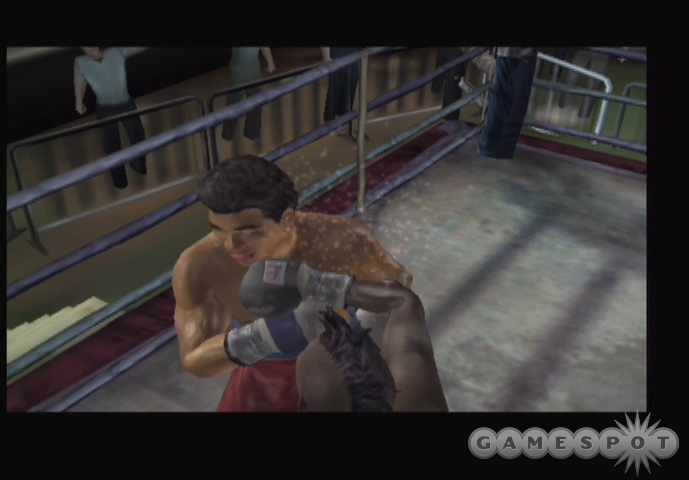Last year's Fight Night 2004 reinvigorated boxing video games, as boxing had become a sports genre that many people had written off years ago. After a sequence of mixed results in the Knockout Kings series, EA Sports' Fight Night came along and introduced entirely new mechanics to the boxing genre, creating a fast-moving and free-flowing style that better reflected the pugilistic arts seen on TV. A year later, the second version in the Fight Night series is here, and it does what it has to do: improves on an already winning formula.
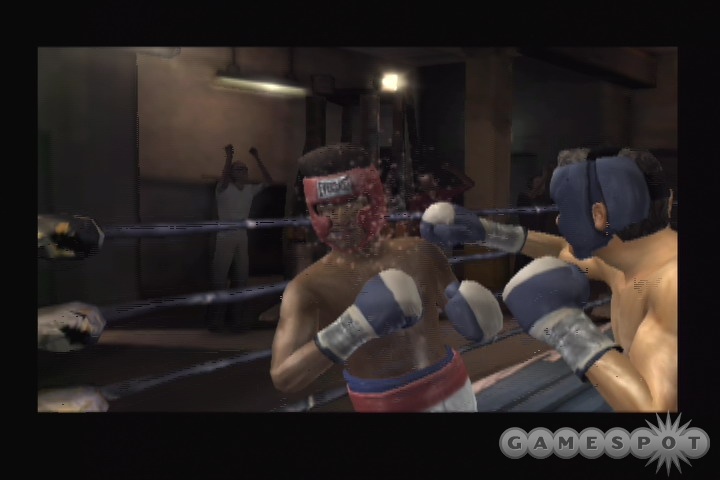
The plodding pace and an overly complex fighting system are what have hurt boxing games. When you enter the virtual ring, the last thing you want to feel is that your boxer has glue on the soles of his shoes, or that you won't be able to execute a simple three-punch combo without memorizing long strings of button sequences. Fight Night Round 2 directly addresses both of these concerns with controls that are responsive, subtle, and effective, giving you a real feeling of mastery over your boxer, even if you're picking the game up for the first time.
First of all, the boxers move across the length of the ring at a nice pace--neither lumbering across the canvas, nor moving too quickly at an unrealistic pace. You can close on an opponent quickly yet backing away from punches is just a tad too slow for comfort, which seems exactly right. On the downside, a fighter's movement doesn't seem to slow down even when fatigued, though punch speed and effectiveness do drop.
Movement, however, is only half of the formula. A great boxing game hinges on the effectiveness of both the offensive and defensive controls, and it's here where Fight Night Round 2 shines. Nearly everything is controlled with a combination of the right analog stick and the trigger buttons. Simple punches--jabs, hooks, and uppercuts--are at your fingertips with a simple flick of the right stick. The design of each control is even set to resemble the punch you throw, so that a quick stinging jab is executed with a single flick of the right stick diagonally left or right; a hook is accomplished by moving the stick to the right and then arcing up; and a devastating uppercut starts out diagonally down and moves up and around, much like the way your boxer's arm moves along the path of the punch.
If you're looking to deal some heavy blows to your foe, you'll need to wind up your punch a little and toss some haymakers into the mix. Controlling haymakers is simple and feels just as natural as regular punches. A haymaker hook, for example, starts out as a normal punch--moving the right analog stick directly left or right--but instead of letting the punch fly immediately, you'll need to wind up the power by pressing down and then up along the arc of the controller. Punches can only be fully wound up when a boxer is standing still, though power punches can still be thrown when the boxer moves. The most powerful punches are best reserved for those times when you have your opponent backed up against the ropes or, better yet, in the corner.
Body shots are executed by combining punches with the left trigger, and it's easy to quickly and effectively mix up your punch types between body blows and head shots. In fact, most combinations are easy to pull off with Fight Night Round 2's control scheme, provided you stay disciplined with your right stick movements. In the heat of the moment, it's easy to forget to let that hook you've wound up continue through its arc, as it's equally easy to simply switch to an opposite side jab. In fact, you'll often feel like your flailing punches at random. But with a little practice, you'll be stringing together one-two-three combos in no time. In fact, the controls in Round 2 are so subtle that slight movement of the right stick will let you pull off shoulder feints to fool your opponent into getting his guard up on one side while you pile on a flurry of damaging punches to the opposite side.
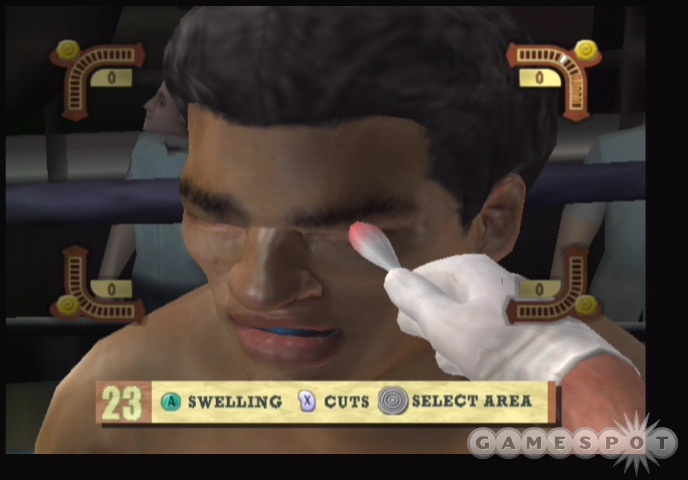
As flexible as the offensive mechanics are, Round 2's defensive controls are just as much so. New for Round 2 is the clinch, a last-ditch effort to regain some stamina just before you get hit with a knockout blow. It's nice to see an effective clinch control enter the mix, and it's even better that clinches can be shrugged off or avoided altogether, preventing the move from being an automatic fail-safe.
Other defensive options include blocks and parries, and these are executed with the right analog stick and right trigger. Parries are especially effective in the game because they leave your foe wide open for counterpunches, which, as you progress up the ranks, become one of the essential keys to victory. Like punches, blocks and parries can be executed both high and low. If you want to block a low hook on the right side, you'll need to make sure that your parry is set up to catch the punch when it lands. Because of this, effective parrying requires a lot of observation of your opponent's tendencies and animations, as well as a lot of practice to get the timing right. Once you do, however, you'll find parries one of the most effective weapons in your arsenal. Finally, the easiest way to make your opponent miss is by dodging, which is pulled off by using the left analog stick and the left trigger in tandem.
This control scheme, which is simple to pick up yet tough to master, makes for a huge variety of matches in Round 2. We've seen all-out slugfests where both competitors basically stand in the middle of the ring and pound each other senseless. We've been chased around the ring by head-hunting maniacs looking for first-round blood, only to outlast them later in the fight. We've introduced opponents to the canvas with the very first punch of the fight. About the only thing we didn't see in our time with Round 2 are fights that go the distance. Whether this is because of our preference for going with power fighters and looking for big-punch knockouts, or because of some other reason, is unclear. Certainly fights go longer the deeper you get into the game, but we have yet to see a fight go the distance and, because of this, we haven't won or lost by decision.
Though throwing punches in Round 2 is fun, watching and hearing them land is twice as nice. The game's graphics and sound effectively convey the force of each successful punch. Even on stinging jabs, your opponent's head will twist back, conveying the force of the blow. With stronger shots, your rival's head will literally rock to the side and his hands will drop down, leaving you to execute a successive flurry of blows. As you land your punishing punches, your opponent's health meter will gradually decrease. When it empties completely, the camera switches to a closer viewpoint, the sound drops out save for the desperate screaming of your opponent's corner man, and you'll be primed to take your rival out with a knockout punch. Desperate to avoid this, your foe will be blocking and parrying madly, so you'll need to prime your punches carefully. Land just the right punch and your opponent will take a dive onto the canvas, often bouncing off the ropes in the process.
It's here, in the KO moment, in which the full might of your punch is revealed. A series of slow-motion replays show the sheer force of impact of your clout landing, complete with flying sweat and, sometimes, spewing blood. The sound of your opponent's grunt slows down to a barely audible guttural moan as his head rocks, his chin flays out with the force of the punch, and his eyes roll back in his head. And then you get a different angle of the same punch. And then another. Each KO punch is a brutal, visceral experience that will have you cackling out loud each time it happens. These KO moments are the primary way of achieving knockdowns, but if you execute the right punch at the right time you will send your opponent diving onto the canvas no matter how much health he has remaining.
Round 2 includes several game modes: quick fight for pick-up-and-play matches, online play (on the Xbox and PlayStation 2), and a career mode, where you can take your boxer up from the amateur ranks all the way to the pinnacle of your chosen weight division. In the pickup bouts, you can use fighters from the game's roster of current and all-time greats, and you can even mix and match weight divisions. Want to know how Bernard Hopkins would fare against Muhammad Ali? You can find out in Round 2 (the answer: not too well). You also have the option to create a boxer of your own by using the game's in-depth and entertaining create-a-champ mode. This is one of the more in-depth create-a-player features we've seen recently, rivaling that of Tiger Woods PGA Tour 2005 in both depth and flexibility.
Online play with Round 2 tends to be hit or miss. While the idea of taking your created fighter online and duking it out with strangers (or friends) is attractive, in execution, however, the mode tended to fall flat in our test sessions. Unfortunately, the controls are not as responsive online as they are in the single-player game. When you're fighting through the career mode, you get used to the snappy pace of your boxer and his instant reactions to any move you make in the game. This isn't the case online, as there seems to be a pause, however brief, in between the movement on the controller and your virtual fighter's response. Though the lag tends to be minimal, in a sport as dependent on timing as boxing, these pauses can be detrimental to the game experience.
Round 2's career mode is the deepest mode found in the game. You'll have two options in this mode: creating a new player from scratch or rebuilding the legend of one of the real boxers found in the game. You can even change the real fighter's fighting style and stance--remake Roberto Duran as a southpaw, or Joe Frazier as a speedster, for example. If you choose to create a boxer from scratch, you'll only have a certain number of points to distribute among attributes, such as power, speed, agility, heart, and cut recovery. Once created to your liking, your greenhorn boxer will start out in the amateur ranks, picking up fights as he can and earning a small purse for each win. The amateur ranks are essentially used to introduce the game's sparring/training mode, but you have the option to skip the amateurs and go straight to the pros if you desire.
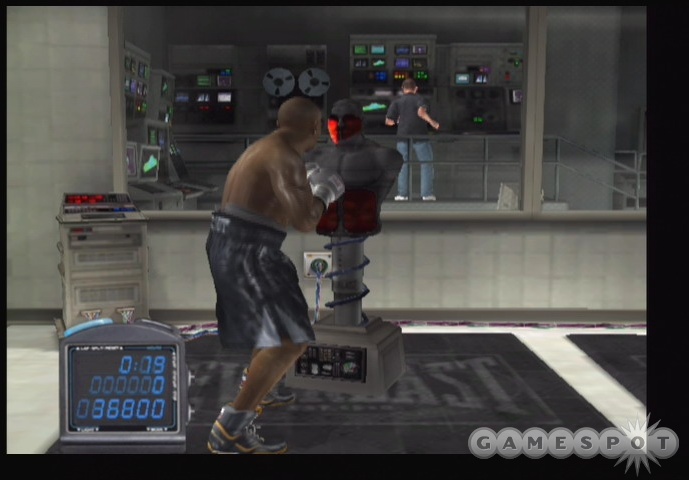
The game's training mode is perhaps its weakest feature. You start off with the basics by landing several punch types in a row. As you progress, you'll be asked to practice dodging, parrying, and blocking blows. Unfortunately, the game doesn't describe how to pull these moves off in the training mode. Those new to the Fight Night series might find this confusing, because unless you consult the game's manual or get lucky with a loading screen that describes the controls for a particular move, you won't have any idea how to progress, except through trial and error. Furthermore, the career mode lacks a sparring feature. If you want to practice your parrying techniques in an unranked situation, you'll have to back out of the career mode altogether.
This doesn't mean that training can't be found in the pro ranks. In fact, you will be focusing your skills in a number of different areas, including heavy bag, combo dummy, and weight lifting (essentially minigames that concentrate on timing and pattern recognition). Each training sessions focuses on specific attributes, such as power or agility, and you'll need to spread your training time out to ensure you consistently improve all your boxer's stats. A nice graphical touch is the very obvious strides your boxer's physique will make in the early training sessions. Start your virtual boxer out as a flabby fatty and he'll quickly evolve into a carved-out-of-wood paragon of fighting fitness after only a few sessions.
Early in your pro career, you're able to leap up the ranks if you so choose, easily besting boxers that are three or more ranks ahead of you. Because your attributes improve after each prefight training session, however, it's probably smarter to take things slow in order to maximize your stats. You'll need every attribute maxed out as you approach the upper echelon of your weight class.

For each win you'll earn cash that can be spent in a number of different areas--from improved trainers and cut men to entrance music and effects and, yes, ring girls. You can also gear up in the fight store, choosing from a large selection of gloves, shoes, trunks, mouthpieces, and foul protectors. Noticeably missing from the gear assortment are robes, which don't play a part in your ring entrances. In fact, ring entrances in general don't have the same kind of flair found in the game's create-a-boxer feature. A more flexible ring entrance design tool--preferably one that supports custom soundtracks and selectable camera angles--would have been a welcome addition.
The further up you move on the rankings ladder, the less wiggle room you'll have for scheduling fights, because the difference between a fighter ranked three spots higher than you is noticeably different from the chump just ahead of you. As such, once you break the top 20, you'll find that your progress toward championship gold slows dramatically. Your opponents are generally stronger and quicker than you, and the artificial intelligence is much more doggedly aggressive and has the tendency not to back off, even if you land multiple combos. As such, if you don't have your defensive game well in hand--the blocking and parrying techniques in particular--you may quickly find yourself out of your league. This is our other gripe with Fight Night Round 2's gameplay. Early on, you focus so much on your offensive game, and you can easily overwhelm opponents (especially if you focus on power shots). You can also skate through the bottom half of the pro ladder, barely ducking or blocking a single punch. Defensive skills aren't needed early on, so what's the point in practicing them? By the time you start fighting opponents who refuse to back off even under heavy pressure, your lack of defense will come back to bite you. While we understand the point of "upping your game" as you reach the top of the pro ranks, we think that an addition of a "free spar" feature, used to avoid punches early in the game, for example, would have made for an easier transition.
Graphically, Round 2 features some of the most impressive player models found in sports gaming. Skin textures are amazingly lifelike and the models animate beautifully. The aforementioned punch animations are vicious and well executed, which is something you never tire of seeing and which never fails to elicit a grimace from passersby. Sweat flies with each landed punch and, in the case of power shots, you might see a spray of blood from your opponent's mouth. Because the boxers are the star of the Fight Night show, the player models of your entourage and ring card girls don't look nearly as intricately detailed. Plus, all of this quality modeling on the boxers means that the game's backgrounds will suffer. While there are a good variety of arenas in which to fight--Staples Center, the grungy 65 Lower Flushing, and the glamorous Hisako Ballroom among them--most seem poorly lit and lacking in detail. The same is true for the ringside crowd, which is barely noticeable most of the time.
From a sound standpoint, Round 2 is solid, if unremarkable. Some noticeable improvements have been made, including a new ringside announcer, ESPN and Fox boxing analyst Joe Tessitore, who is a marked improvement over the horrible Big Tigger from the previous game. While Tessitore's commentary is enthusiastic and more professional sounding, his calls can be vague, especially when describing missed punches. While your ringside trainer will give you advice in between rounds--while you're busy healing cuts and reducing swelling using the game's new cutman feature--his commentary is pretty limited and sometimes directly contradicts itself. One second you just had a "great round" and the next you're going to need to "get it together" if you hope to have a chance in the fight. EA Trax rears its ugly head again with a mix of hip-hop tunes that, though limited in scope, certainly fit the boxing vibe. But perhaps more so than any other EA Sports title, the Fight Night series begs for custom soundtracks.
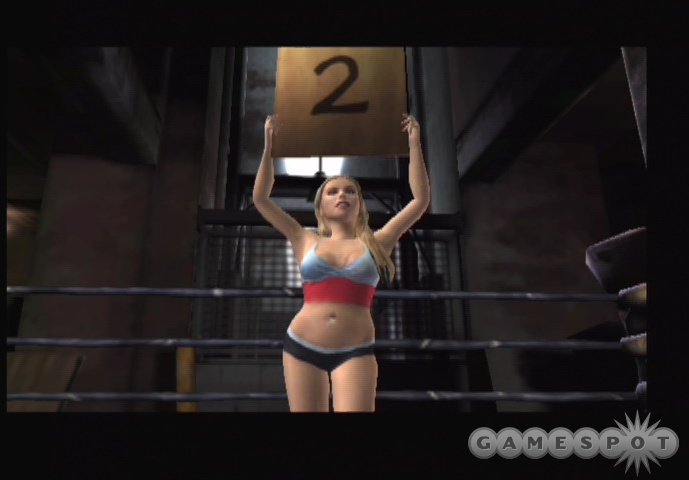
Beyond some important feature distinctions, there is little difference between the three console versions of Round 2. Graphically, the PlayStation 2 version of the game holds its own against both the Xbox and GameCube versions, and all three console controllers work fine with the game. The small C-stick on the GameCube controller, combined with its eight-point articulation, might require some practice to use, especially if you've played Fight Night 2004 on a different console (but it's generally not a big deal). Load times are prevalent on all three versions, but it's only ugly on the PS2 version of the game. As you might expect, online play is only enabled for the Xbox and PS2 versions, but GameCube owners should not feel slighted, as they've got the benefit of the full SNES version of Super Punch-Out!! to play when realistic boxing action just doesn't cut it anymore. Little Mac, star of Super Punch-Out!!, is also an unlockable character in the GameCube version of Round 2.
There's a lot to like about Fight Night Round 2, most obviously a deep and involving boxing mechanic that allows you to be creative in your approach to the fistic arts. As a sequel to the well-received Fight Night 2004, the game improves on many aspects of its predecessor and ends up as one that will continually challenge your skills the longer you play it. Even though online play should be more responsive, you can still attract anyone looking to mix it up on the Internet. There's still room for improvement to the Fight Night series, but it only leaves us eager to see what comes next.
